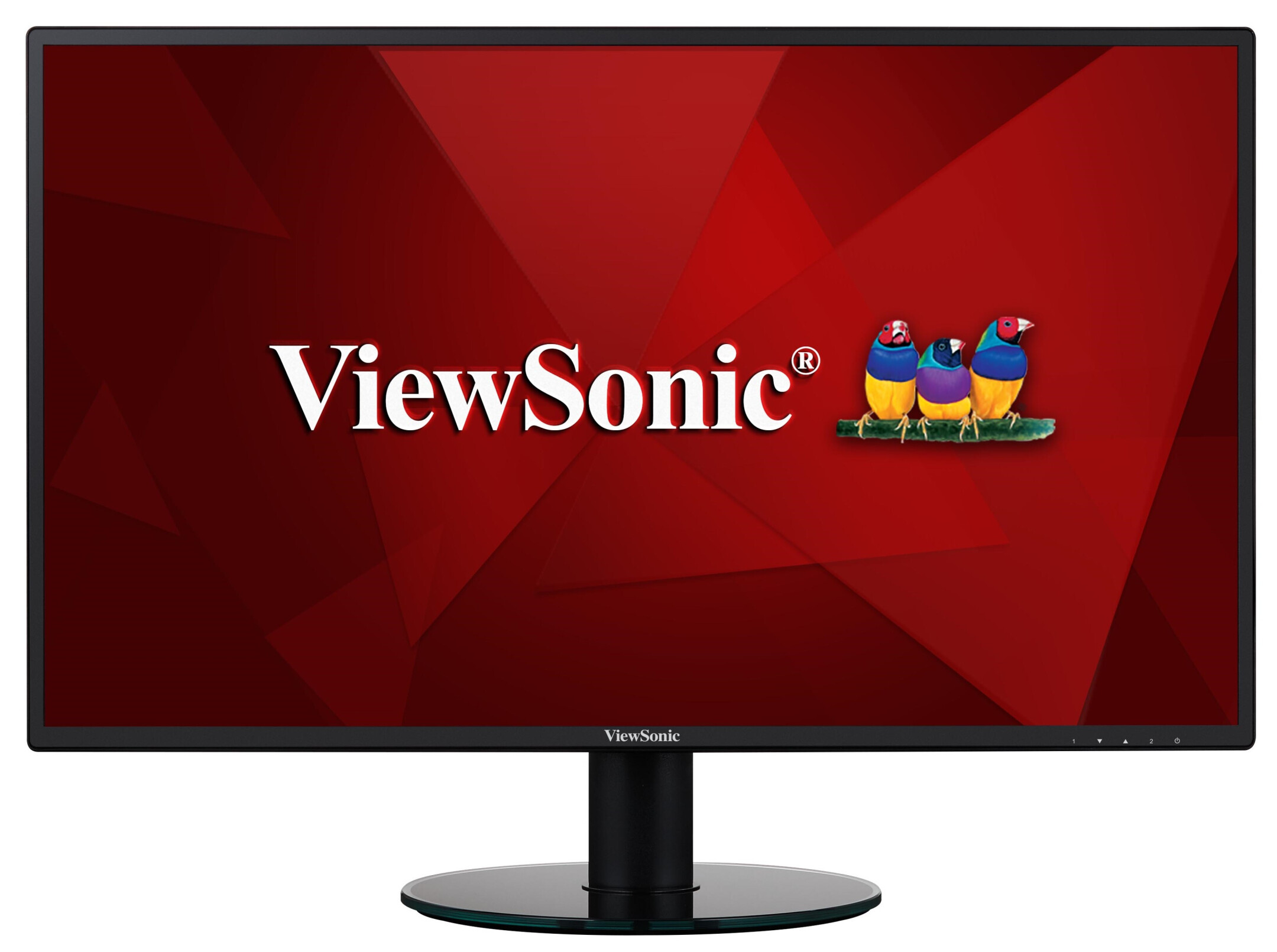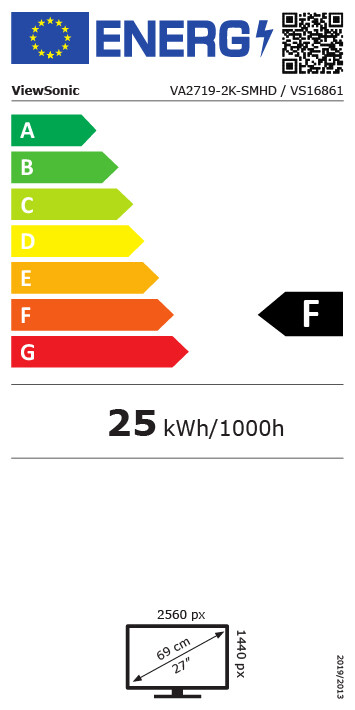































£429.97*
- Resolution 2560 x 1440 QHD / WQHD
- Diagonal 27"
- panel technology IPS
- Refresh Rate 60Hz



Frequently purchased together
Product information
Features
Wide Quad HD Resolution
SuperClear® IPS Panel Technology
The Power of HDMI
Slim Bezel Design
Optimized View Settings
Description
The ViewSonic® VA2719-2K-Smhd is a 27" WQHD monitor that delivers solid multimedia features at a great value with flexible connectivity, wide-angle viewing, and amazing screen performance. Featuring 2560 x 1440 resolution and a slim bezel design, this monitor provides a near-seamless viewing experience ideal for multi-monitor setups. Whether for working at the office, or enjoying entertainment at home, the VA2719-2K-Smhd also features DisplayPort and HDMI ports for flexible connectivity to PCs, laptops, and other multimedia devices. In addition, along with one of the industry’s best pixel performance policies, makes the VA2719-2K-Smhd a great overall value choice.
Wide Quad HD Resolution
At four times the resolution of a traditional 720p panel, and almost double that of a traditional 1080p display, WQHD results in a much sharper image, with no distortion or stretching, all while maintaining the same 16:9 aspect ratio.
SuperClear® IPS Panel Technology
Enjoy accurate and vivid colors with consistent levels of brightness no matter the vantage point. With SuperClear IPS panel technology, this monitor delivers the same image quality whether you are looking at the screen from above, below, the front, or the sides
Versatile Connectivity
HDMI and DisplayPort inputs give you the freedom to connect your display to a variety of high-definition devices.
Slim Bezel Design
The slim bezel delivers an increased screen surface area that lets you see more without taking up valuable desktop real estate. In addition, the slim bezel enables easy configuration of multi-screen setups with a sleek, fashionable look that stands out in any setting.
Optimized View Settings
ViewSonic’s unique ViewMode™ feature offers “Game,” “Movie,” “Web,” “Text,” and “Mono” presets. These presets enhance gamma curve, color temperature, contrast, and brightness to deliver an optimized viewing experience for different screen applications.
Technical data
| Name | ViewSonic VA2719-2K-SMHD 27" IPS Monitor, 2560 x 1440 QHD / WQHD, 60Hz, 14ms |
|---|---|
| Article number | 1000002875 |
| GTIN/EAN | 0766907899139 |
| Manufacturer SKU | VA2719-2K-SMHD |
| Model name | VA2719-2K-SMHD |
| Brand | ViewSonic |
| Product Type | Monitor |
| Product Series | ViewSonic VA Series |
| Technology | LCD Technology LED: LED is a lighting technology. With LED technology, diodes are used as illuminants and not conventional UHP lamps. The advantage of this technology is that the diodes do not use a filament and practically do not consume energy. However, LEDs have a more bluish colour range than UHP lamps, which is why the image is often perceived as somewhat colder. Colour wheel: Besides the DMD chip, the colour wheel is one of the most important criteria for image generation in DLP projectors. The colour wheel rotates constantly at extremely high speed and currently has 3, 4, 5 or, in some cases, even more colour segments. Through the colour wheel, the light from the projector lamp is alternately broken down into the primary colours red, green and blue practically without interruption. In modern projectors, the colour wheel also contains white and sometimes other colours such as cyan, magenta and yellow. With 3 segments, the colour wheel rotates at 3600 or 7200 rpm, with 7 segments at up to 14400 rpm. (4x speed). Each colour perceived by the eye in a DLP projector is therefore an extremely fast sequence of individual, differently coloured light beams until the actual processing. Because this technology sometimes does not use all the colour positions of the colour wheel for high-contrast images, or because the colours required for colour mixing are arranged far apart on the wheel, some viewers recognise the rainbow effect. This characteristic is more noticeable with slower colour wheels and slower rotation speeds than with projectors with faster and more frequently segmented colour wheels. |
| panel technology | IPS |
| backlight | LED |
| Resolution | 2560 x 1440 QHD / WQHD Resolution Resolution: The resolution of a projector is the maximum number of image points (pixels) that a projector can display based on its naturally existing technology, i.e. without conversion or cropping of the image. The native resolution is the number of pixels that a projector physically has to display the image. A projector usually interpolates a resolution when it receives an image signal with a higher resolution than the native one. If this is the case, there may be a lack of image detail or general blurring in the displayed image. If a projector receives an image signal with a lower resolution than the native, it also interpolates, it scales the image up to the native resolution, calculates corresponding additional pixels, if possible without changing the image information. The disadvantage here is that although the image is displayed larger than fed, the original individual pixels may become much more visible as they are multiplied by the conversion. 4K: 4K refers to the resolution of 3840 x 2160 or Ultra High Definition Television (UHDTV). This resolution corresponds to 4 times the resolution of Full HD. To record films with this resolution, special cameras are needed that can record at around 8 megapixels (4K). Full HD: The term Full HD is used to describe devices that can physically display or output HDTV signals in full (1920 x 1080 pixels). 1080p: 1080p is the specification of the vertical picture lines. Among other things, it refers to the resolution 1920 x 1080. The "p" in this case means full frames, so all picture lines are displayed simultaneously. 1080i: 1080i is the specification of the vertical picture lines. The "i" in this case means fields. This signal is usually displayed interpolated (e.g. by devices with a 1280 x 720 HDready resolution). The interpolation digitally adds pixels, but also offers a slight blurring. In contrast, 1080p playback uses full frames. |
| Diagonal | 27" |
| Aspect Ratio | 16:9 Aspect Ratio Format: The projected image is output in a format (aspect ratio) specified by the projector. The format is also determined by the resolution of the projector (see also the entry "Resolution"). The screen format is usually selected on the basis of the format of the beamer image. The most common formats are 4:3, 16:9 and 16:10. |
| Contrast Ratio | 50,000,000 :1 Contrast Ratio Contrast: The contrast reflects the gradations between the lightest and darkest point. This is determined from white to grey to black. The higher the contrast, the more precisely the individual gradations between the respective sections can be recognised. In real use, however, the contrast actually only plays a role in darkened rooms, as the light counteracts the contrast. Therefore, contrast plays a rather subordinate role in presentation devices. It should also be noted that the contrast is determined differently depending on the technology. This often results in very different values on paper. Black level: The black level indicates the lowest light value of the projection that is achieved when projecting a black image. The better the black level, the more the dark colours / black tones are emphasised in the image. |
| Max. Brightness | 300 cd/m² |
| Response time | 14ms |
| Refresh Rate | 60Hz |
| Support - VESA | 100 x 100 |
| Product width | 62 cm |
| Product height | 36.2 cm |
| Product depth | 4.5 cm |
| Weight | 4.5 kg |
| Colour | Black |
| EEK Spectrum | A to G |
| Energy efficency class | F |
| Condition | New |
| Warranty | 24 Month |
| Warranty type | Bringin service Service and support information |
Manufacturer's warranty information:
Here you will find more detailed information on the different types of warranty. Please refer to our manufacturer overview for contact details and warranty conditions for the corresponding warranty claim. Statutory warranty rights are not restricted by an additional manufacturer's warranty. Our liability for defects is governed by law. Defect rights can be claimed free of charge.
Downloads
Product safety
| Person responsible for the EU |
|---|
| ViewSonic Technology GmbH |
| Fürst-Leopold-Platz 1 |
| 46284 Dorsten |
| Germany |
| sales-uk@viewsonic.com |





